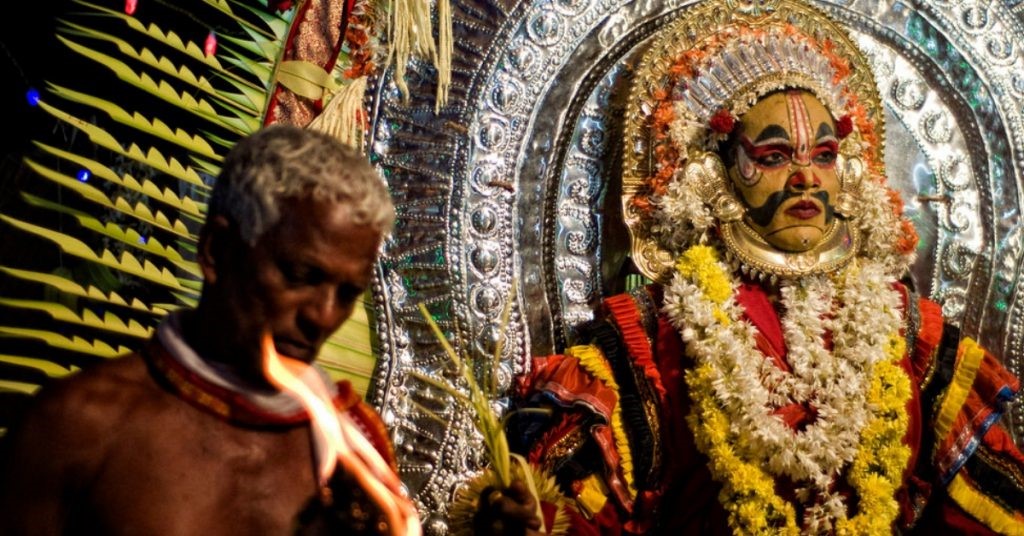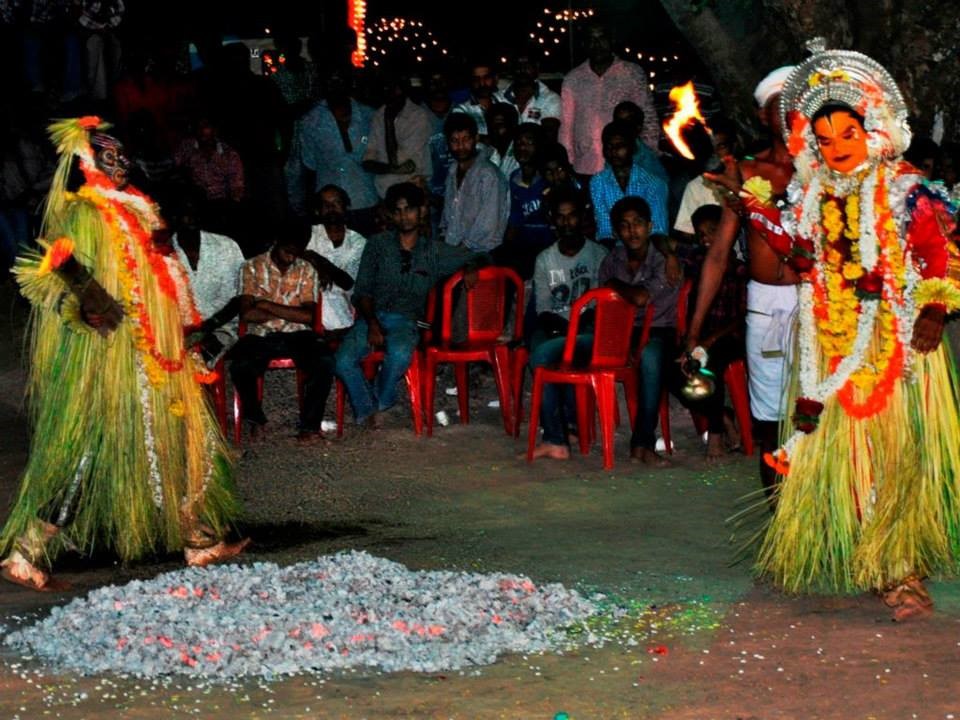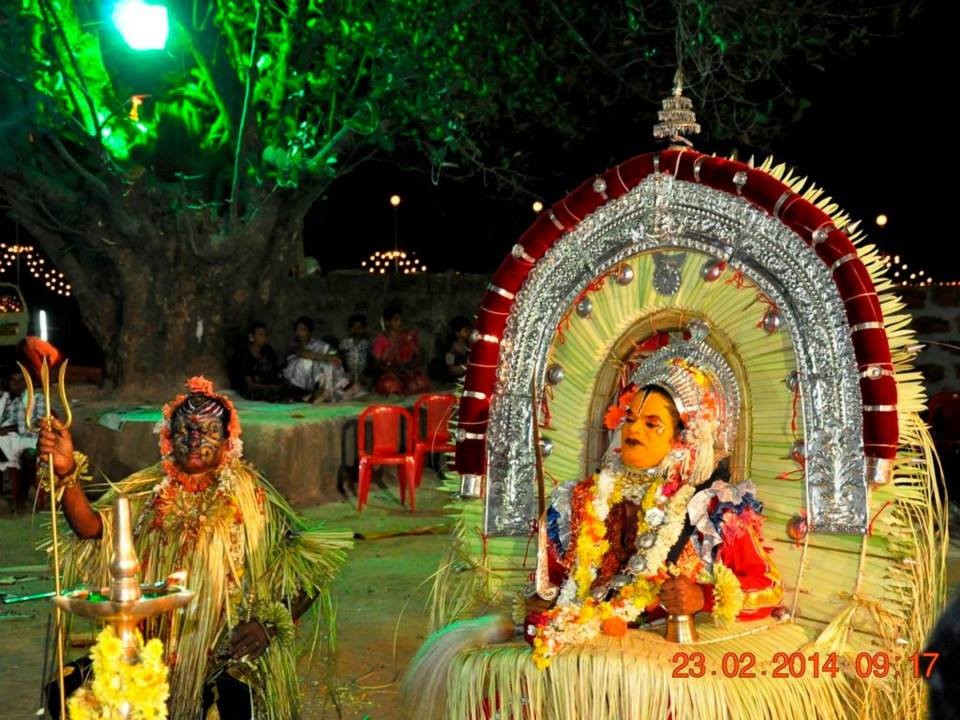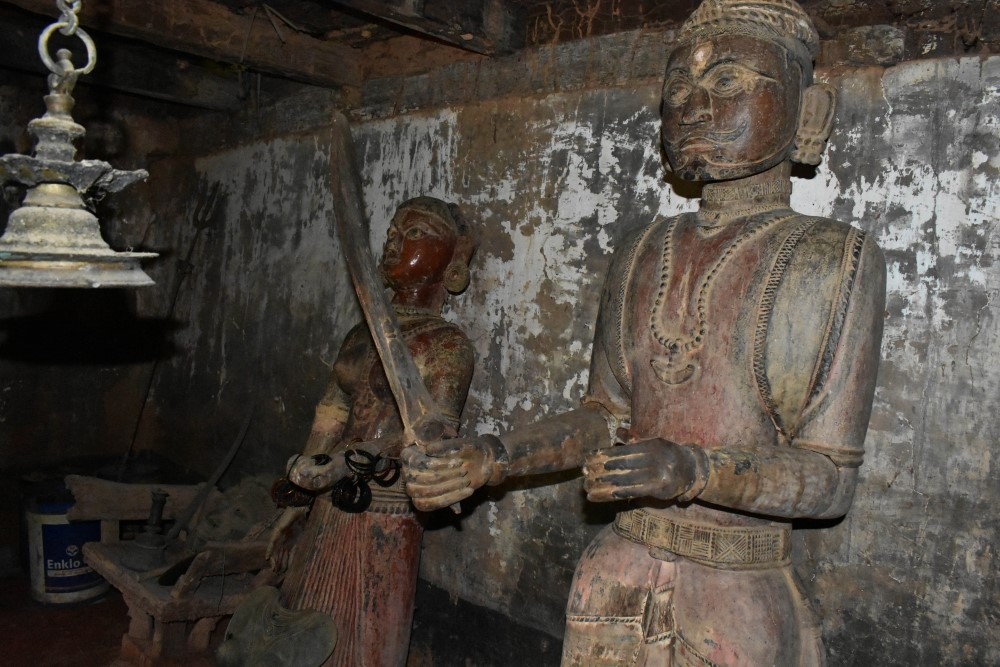Bhoota Kola: The tradition of Spirit Dance in Tulunadu
Rituals of spirit invocation celebrated in Tulunadu evoke gripping psychological effect and mythical grandeur, an account by Alisha Padmanabha
 As the dusk merges into a December evening, members of Manjunath’s family look charged, super active. All out preparation is on. Someone is preparing the dress and cleaning adornments to be worn in the night, another is preparing the paints made from natural ingredients to be used for makeup. Manju’s cousin is busy at the place of performance, supervising arrangements. All are busy with their assigned work as the family gears up to perform Bhoota Kola, their age old traditional ritual dance they are very much proud of.
As the dusk merges into a December evening, members of Manjunath’s family look charged, super active. All out preparation is on. Someone is preparing the dress and cleaning adornments to be worn in the night, another is preparing the paints made from natural ingredients to be used for makeup. Manju’s cousin is busy at the place of performance, supervising arrangements. All are busy with their assigned work as the family gears up to perform Bhoota Kola, their age old traditional ritual dance they are very much proud of.
Bhoota Kola or Bhutaradhane is a ritualistic dance tradition celebrated by the ‘Tuluvas’ (native Tulu speakers) spread across coastal Dakshina Kannada and Udupi districts of Karnataka and Kasargod taluka of Kerala, collectively known as Tulunadu. In Kerala part of Tulunadu it is called Theyyam. Annually performed in the months of December and January, it is typical by its nature where local Daivas or spirits are invoked and channelized by specialist ritual dancers from Nalike, Pambada, or Parawa communities.
‘Bhoota’ means Spirit and ‘Kola’ is dance. Dance of spirits through possessed human mediums. Recital which is known as Paddanas (ballards) in old Tulu language recounts the origin of these spirits and their connection with that particular location. They are the lesser known local deities who protect the village from calamities and bring prosperity to village folks.
In Bhoot Kola, magnificent blend of colors, costumes, face painting, dance, music and storytelling with the tinge of mystic esoteric elements from possessed spirits add to the adrenalin rush. Origin of this tradition, according to its practitioners, dates back to 700-800 BC coinciding with the arrival of early Tulu tribes who brought with them the cult of Barmer, also pronounced as Birmer or Bermeru, later to become the part cultural traditions of the area surrounding Mangalore.
This ritualistic folk dance performance brings thrill and awe, and is scary, fascinating to watch. With the thick rural night acting as the back drop, sparsely lighted by oil lamps and torches, to the rhythmic beating of Chande and other musical instruments such as Maddale, Uduku, Vadya, Lollu and Dollu step dance of performers carrying swords or other such weapon and high pitch recitation of Paddana, all together, create an atmosphere of mystical ograndeur, gripping psychological effects on the minds of spectators, who prostate with utmost regard before the possessed performer, seek blessing considering him as the personification of the spirit the performer represents.
 Interestingly, all the spirits or Daivas as the people call them who are invoked to possess a performer are mostly of totemic origin. They are neither bad nor good. However, their wrath must be avoided. Few spirits are represented as the attendants (Gana) of Shiva and his consort. Each deity carries her/his own distinct story, background, physical representation ad role. There is also difference in offerings to these spirits. Flowers, rice, bananas and such other things are offered to the Puranic spirits; the tribal totemic spirits are offered liquor and meat. In some places around Mangalore, only four Daivas: Kalushti (female), Kalkudae (Male) Guligae (Male) and Panjoli (Female) are worshiped. Kalushthi and Kaludayi acts as sister-brother duo as is the case with Guligayi and Panjoli. These duos are meant to be siblings. In the first-half, Kalushti and Kalkudae come and play their parts, then appear Guliga and Panjurli. Other popular spirits are Bobbarya, Pilipoota,, Pilichamundi, Koti Chennaya, Jumadi, Jarandhaya, Kallurthi, Panjurli, Koti-Chennaya, Kantabare-Boodabare, Koraga-Taniya, Abbage-Daarage, Kodamandaya, Pili (tiger), Maisandaya (buffalo), etc.
Interestingly, all the spirits or Daivas as the people call them who are invoked to possess a performer are mostly of totemic origin. They are neither bad nor good. However, their wrath must be avoided. Few spirits are represented as the attendants (Gana) of Shiva and his consort. Each deity carries her/his own distinct story, background, physical representation ad role. There is also difference in offerings to these spirits. Flowers, rice, bananas and such other things are offered to the Puranic spirits; the tribal totemic spirits are offered liquor and meat. In some places around Mangalore, only four Daivas: Kalushti (female), Kalkudae (Male) Guligae (Male) and Panjoli (Female) are worshiped. Kalushthi and Kaludayi acts as sister-brother duo as is the case with Guligayi and Panjoli. These duos are meant to be siblings. In the first-half, Kalushti and Kalkudae come and play their parts, then appear Guliga and Panjurli. Other popular spirits are Bobbarya, Pilipoota,, Pilichamundi, Koti Chennaya, Jumadi, Jarandhaya, Kallurthi, Panjurli, Koti-Chennaya, Kantabare-Boodabare, Koraga-Taniya, Abbage-Daarage, Kodamandaya, Pili (tiger), Maisandaya (buffalo), etc.
Bhoota Kola performances are of four types. The first category is Kola in which the performance is staged at the spirit worship place in the village, called Sthana where the Daiva is said to reside. Bandi form of Bhoota Kola is akin to Kola with the addition of people dragging a car on which the performer sits. Nema is a private ceremony held at the house of a person who is willing to conduct this ritual and invites Kola performers. It can be performed once every two years or in ten, fifteen or twenty years, mostly organized by rich families. In Agelu-Tambila, ancestor of a family along with other spirits are offered rice, dishes, alcohol once in a year after the fulfilment of a wish. The dance continues throughout the night. At the end of this ritualistic performance, the possessed spirit grants the devotees blessings and instills confidence to face any problems, difficulties and obstacles. They also provide solutions to resolve interpersonal or village disputes through arbitration.
Akin to other cultural practices, Bhoota kola was significantly related to the pre-colonial administrative arrangements of guttumanes (guttu homes). Guttu or Guttumane were unique traditional manor households spread across Tulunadu and were considered as traditional administrative centres. The power vesting on the heads of guttumanes was partly attributed to Bhoota Kola. Head of a village unit received authentication by the possessed spirits as they organized the ritual and stood as the chief patron of Bhoota Kola. Possessed spirit recognized Guttu owner as representative guardian of the village on his behalf, and vested power on him to rule and protect the village. The invoked spirit would stand before the guttu owner after paying respect to other guardian spirits of the village and pay respect to him as the village chief . Dharma Nema, roughly translated to justice ritual within the format of Bhoota Kola is bestowing power to designated head of a Guttu called Pattadhikari. This power bestowing ritual is called Gadipradhana, which means, officially anointing the person as the head of the village to rule. Post this anointment, the head exercises self-restraint like celibacy, vegetarianism, strict and short sleeping schedules and purity rituals. His position also becomes more tenable with less opposition because of the stamp of authority bestowed on him by village guardian spirits. This ritual continues even to the present day.
Daivakone (room of the guardian spirit) is the place where masks, swords, shields, bells, crowns, palanquins and statues made from bronze, silver, and, sometimes, gold’ all of which are significant for Bhootaradhane are stored. The structure of this place is not altered without having consultation with and supervision of cult experts. Women are not allowed entry into Daivakone.
Trained professional dancers perform Kola. It is a family tradition in which members of a family performs character of different spirits. They get paid. Training starts from young age starting with assisting elder family performers in make-up, dressing, or preparing garments by shredding tender coconut/palm leaves for Kola performers. They learn steps and dancing to the rhythm of music, prepare their body to channelize the spirit, mimic the performance of their elders, learn rituals involved in performance and follow disciplines like abstaining from taking non-vegetarian food, alcohol etc. to become a medium when their time comes. They also need to build up body strength and stamina in order to pe rform for long hours.
rform for long hours.
As the evening approaches, Patri (kola performer) carries out face make up to the accompaniment of music played at the back ground. Activities such as cutting of plantain, cock fight, arrival of Bhandara, hoisting of flag are already done. Bhandaara or Bhoota’s paraphernalia is brought in a procession to the beautifully decorated Angala (the courtyard for ritual performance). The priest does rituals to invoke the spirit. He then prepares himself for the performance. The Angala is decorated with flowers; traditional torches are placed around. Make up sessions of Daivas are a visual treat to watch. Vibrant, bright colors painted on a face with intricate detailing is aimed at offering the effect of mysterious look. The eyes are painted black to hide the eyes of the performer making it difficult to identify him. Rest of the face of Daiva is painted with orange, red or yellow. With traditional dresses, the performers also wear long skirts made from tender palm leaves.
Before the dance commences, the performers is offered a pair of Gaggara (anklet) considered sacred. After seeking and getting permission from village dignitaries, he wears the anklets and is ready for performance. His body starts trembling and slowly he gets into a trancelike state as the beating of drum intensifies and becomes louder. He shouts incantations, growls as if the spirit has taken possession of him and performs feats such as eating fire and burning torch on his chest. Bhootas also wear Ani, a hollow mat-like adornment on the back, and mask. People offer him rice and coconut as token of respect.
There are two types of possessed performers. The first type is known as the Patri. They are usually from Billava community. The second type of medium typically are from communities such as Pambada, Parava or Nalike. Patri carries only a sword and a bell as ritual tools. The medium uses makeup, ornaments, masks etc. After being possessed, the medium may speak as the spirit in the first person and about the spirit in the third person while recounting Pa?dana or tales. However, the Patri speaks as the spirit in the first person.
Paddannas form an integral part of Bhoota Kola and considered as an important part of much loved Tuluva oral literature. These are the narratives about Bhootas or spirits and carry many variations while sticking to the main theme of the narrative. Paddannas have no single author as is evident with other oral literatures. It acts as the bridge between the past and the present by legitimizing the former. Paddanna singers are traditional narrators of the history of their native land, speaking about their unique socio-cultural background with much emphasis on its continuation. (Inspired by Sri Soumyajee)